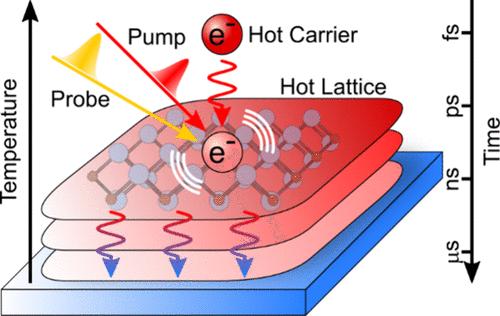Ti2CTx MXene 薄膜中的超快载流子和晶格冷却
IF 9.1
1区 材料科学
Q1 CHEMISTRY, MULTIDISCIPLINARY
引用次数: 0
摘要
由于具有高导电性和强光-物质相互作用,金属二氧化锡是一种很有前途的二维储能、(光)电子学和光子学材料。二氧化二烯中的能量耗散是光电和光热应用的基础。与广泛研究的 Ti3C2Tx 薄膜相比,我们在此应用超快激光光谱技术,在较宽的时间范围(飞秒到微秒)内研究新兴 Ti2CTx 薄膜中电子和晶格的冷却动力学。Ti2CTx 中的载流子冷却时间持续为 2.6 ps,没有热声子瓶颈。热载流子冷却完成后,Ti2CTx MXene 的瞬态吸收光谱可以很好地用热致变色效应来描述。MXene 薄膜中的热耗散发生在数百纳秒内,Ti2CTx 的热扩散率为 0.06 mm2 s-1,Ti3C2Tx 的热扩散率为 0.02 mm2 s-1。我们的研究结果揭示了 Ti2CTx 薄膜的能量耗散动力学,展示了其在能量转换中的潜在应用。本文章由计算机程序翻译,如有差异,请以英文原文为准。

Ultrafast Carrier and Lattice Cooling in Ti2CTx MXene Thin Films
Metallic MXenes are promising two-dimensional materials for energy storage, (opto)electronics, and photonics due to their high electrical conductivity and strong light–matter interaction. Energy dissipation in MXenes is fundamental for photovoltaic and photothermal applications. Here we apply ultrafast laser spectroscopy across a broad time range (femto- to microseconds) to study the cooling dynamics of electrons and lattice in emerging Ti2CTx thin films compared to widely studied Ti3C2Tx thin films. The carrier cooling time in Ti2CTx is persistently ∼2.6 ps without a hot-phonon bottleneck. After hot carrier cooling is completed, the transient absorption spectra of Ti2CTx MXene can be described well by the thermochromic effect. Heat dissipation in MXene thin films occurs over hundreds of nanoseconds with thermal diffusivities ∼0.06 mm2 s–1 for Ti2CTx and ∼0.02 mm2 s–1 for Ti3C2Tx, likely due to inefficient interflake heat transfer. Our results unravel the energy dissipation dynamics in Ti2CTx films, showcasing potential applications in energy conversion.
求助全文
通过发布文献求助,成功后即可免费获取论文全文。
去求助
来源期刊

Nano Letters
工程技术-材料科学:综合
CiteScore
16.80
自引率
2.80%
发文量
1182
审稿时长
1.4 months
期刊介绍:
Nano Letters serves as a dynamic platform for promptly disseminating original results in fundamental, applied, and emerging research across all facets of nanoscience and nanotechnology. A pivotal criterion for inclusion within Nano Letters is the convergence of at least two different areas or disciplines, ensuring a rich interdisciplinary scope. The journal is dedicated to fostering exploration in diverse areas, including:
- Experimental and theoretical findings on physical, chemical, and biological phenomena at the nanoscale
- Synthesis, characterization, and processing of organic, inorganic, polymer, and hybrid nanomaterials through physical, chemical, and biological methodologies
- Modeling and simulation of synthetic, assembly, and interaction processes
- Realization of integrated nanostructures and nano-engineered devices exhibiting advanced performance
- Applications of nanoscale materials in living and environmental systems
Nano Letters is committed to advancing and showcasing groundbreaking research that intersects various domains, fostering innovation and collaboration in the ever-evolving field of nanoscience and nanotechnology.
 求助内容:
求助内容: 应助结果提醒方式:
应助结果提醒方式:


